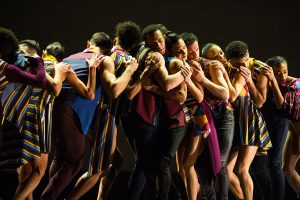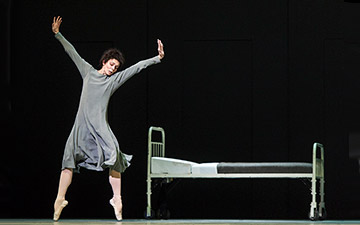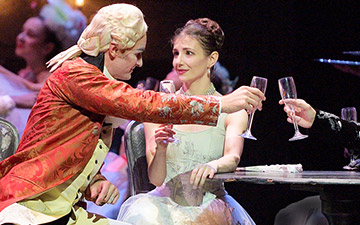
Smuin Contemporary Ballet
Hump Day Ballets: Indigo
★★★★✰
Streamed archive recording of 23 Sept 2016 performance at the Lesher Center for the Arts, Walnut Creek. Relay 24 June 2020
www.smuinballet.org
Over the last four months, dance companies everywhere have had to get creative with their programming. Mine new channels to reach out to their audiences. Experiment with different ways to keep the artistic spark alive as theaters and performances spaces currently sit empty.
A popular option with many groups has been to delve into their repertory archives and share past performances. San Francisco’s Smuin Contemporary Ballet, under the Artistic Direction of Celia Fushille, has joined these ranks with their Hump Day Ballets – a midweek series that showcases a different Smuin ballet each week, streamed to viewers on a variety of platforms. Last Wednesday’s selection was Stanton Welch’s Indigo, a one-act contemporary octet (for four women and four men) originally created for Houston Ballet in 1999. Smuin added the evocative twenty-minute work to its repertoire in 2016, and it was a fall 2016 performance of the piece that the company transmitted. Set to an invigorating Vivaldi cello score, I was familiar with Indigo’s central pas de deux, having seen it as part of a benefit concert some years back, but this was my first experience with the complete ballet. It was a good one.

© Chris Hardy. (Click image for larger version)
Indigo is one of those dances that doesn’t seem totally abstract, yet doesn’t follow a linear path either. It’s more about concept and emotions. Layers and extremes. Just like the color indigo itself. Of course, we all know indigo as one of the seven components of the rainbow. But if you read more about the color, you discover that indigo’s hue is vastly complex, combining clarity, depth, vivacity, coolness, regality and more. From its opening moments through its internal chapters to the final blackout, Welch imbued Indigo with similar choreographic breadth and range. Staccato port de bras and mechanized upper body motions. Sweeping romantic spins and lifts. Courtly pas de basques. Whimsical flutters of the wrists, toes and torso. It all fit together beautifully – not a step felt out of place.
Indigo’s main pas de deux, danced at this performance by Erin Yarbrough-Powell and Ben Needham-Wood, continued the exploration of extremes. From collapsing contractions to classic promenades to the final image, where Needham-Wood lifts Yarbrough-Powell in a chair position high above his head, you couldn’t predict where the phrase material might venture from one moment to the next. The unexpected surprises, like that stunning picturesque lift, added such excitement and electricity to the scene. Akin to the dynamic and changing phrase material, Indigo’s mood and emotion was deliciously unfixed, running the gamut from passionate to refined, desperate to exhilarating, emphatically charged to calmly sedate.

© Chris Hardy. (Click image for larger version)
With its sharp directional changes and strong lunge vocabulary, power was the name of the game in one of the ballet’s middle sections. And the finale movement had some wonderful spatial architecture. Scattered around the stage, the women danced one phrase in unison, while the men simultaneously performed a contrasting one. The space was so alive, and the rousing energy read quite clearly, even through the video format.
The only element in Indigo that didn’t work was the costumes (also designed by Welch), or more specifically the women’s costumes. The men’s attire was absolutely fine – one-piece practice unitards that felt kind of seventies, an era that I’m quite partial to. The women’s wardrobe looked inspired by two-piece swimsuits, with three quarter-length sheer skirts cut up to the waist on either side. Indigo was so elegant, and the men looked primed for that elegance, but for me, the women’s attire just didn’t make sense. It looked haphazard, and there was nothing haphazard about the choreography, the concept or Smuin’s performance of this piece.
As a total aside (not particularly related to Indigo), I loved watching a performance from four years back. Some of Indigo’s cast is still with the Smuin company, while others are not. The experience was a bit like opening a time capsule, albeit a recent one, and seeing once again those dance artists that have moved on to new adventures.

















You must be logged in to post a comment.